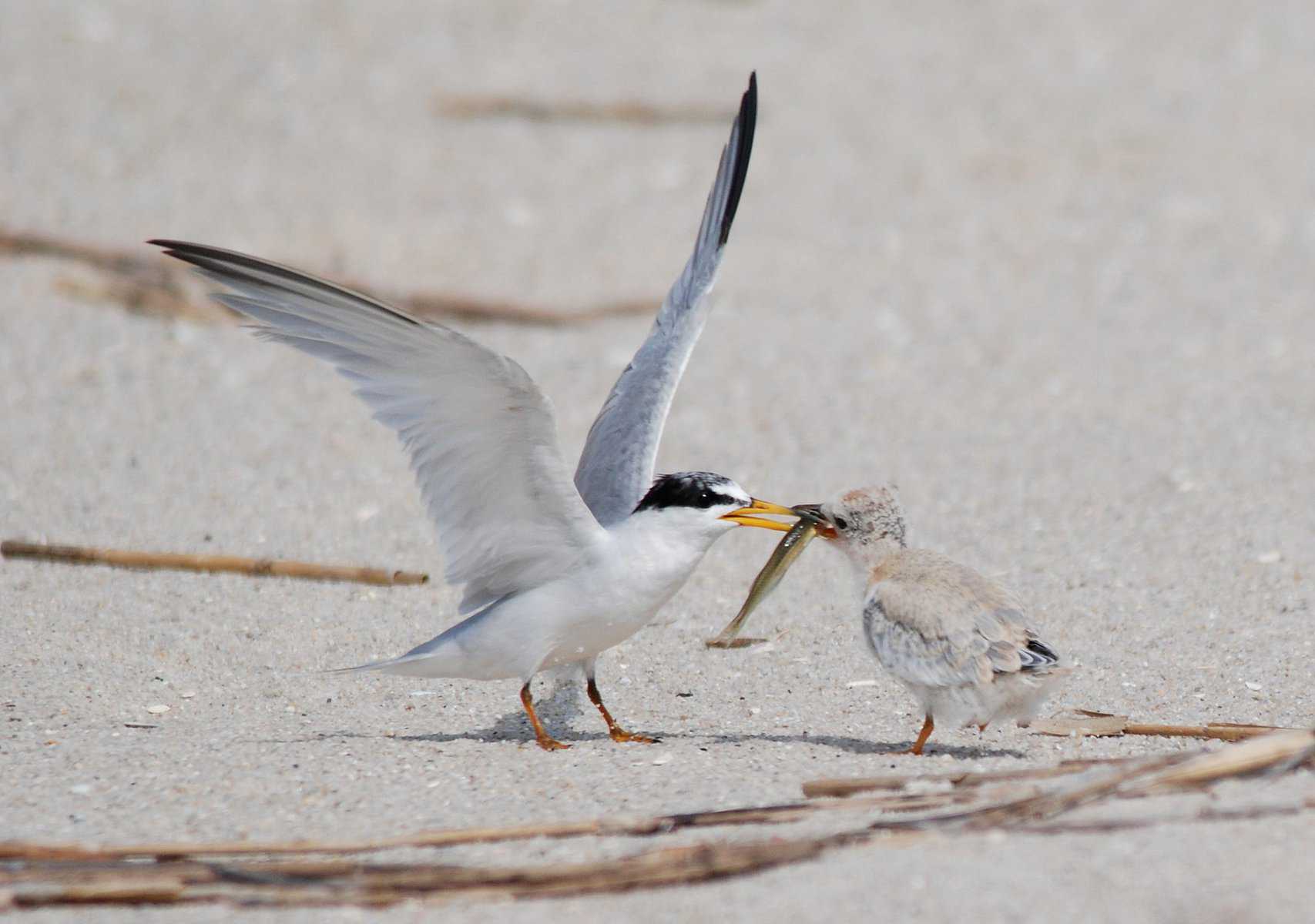by Jay Watson, Co-Executive Director, New Jersey Conservation Foundation
Memorial Day weekend marks the unofficial start of beach season at the Jersey shore. As if a switch has been flipped, beaches along the ocean and bays go from quiet and deserted to buzzing with human activity.
The season does not begin as suddenly for migratory shorebirds that make New Jersey their summer breeding home. Birds arrive throughout the spring according to their own internal schedules.
Four shorebird species – piping plovers, least terns, black skimmers and American oystercatchers – quite literally have their own beach season, since they make their nests directly in the sand. If you’re planning a trip to the beach, be on the lookout for these birds and give them space. They’re fascinating to watch, but all are imperiled and struggling to maintain their populations.
It’s hard to miss American oystercatchers when they land on a beach, as these large, charismatic shorebirds announce themselves loudly and raucously. Oystercatchers are striking in appearance, with long pointed red-orange bills, yellow-orange eyes and black and-white patterning.
Least terns – so named because they’re the world’s smallest tern – will grab your attention when you’re gazing out at the ocean. Least terns are among the most acrobatic of shorebirds, gracefully executing high-speed dives into the water to catch small fish. They’re distinctive for their yellow bills, slender pointed wings and forked tails.
Black skimmers are black above and white below, with black-and-red bills and orange-red legs. They use their long, uniquely-shaped lower bills like spoons, skimming across the water to scoop up fish. Because they feed more by touch than sight, they can even forage at dawn, dusk and nighttime.
While oystercatchers, skimmers and least terns are easily recognizable, it’s easy to miss piping plovers on the beach, since the coloring of these small, round shorebirds match the sand. The bulk of their breeding populations are concentrated in two locations: at Sandy Hook at the north end of the shore, and at the Forsythe National Wildlife Refuge to the south. In these dynamic locations, beaches grow and evolve naturally, and are never machine-raked to provide the sterile environment that people favor but cannot support wildlife.
Piping plovers are the most imperiled of New Jersey’s four beach-nesting shorebirds. They’re listed as “threatened” under the federal Endangered Species Act, and as “endangered” by the state Department of Environmental Protection (DEP). Least terns and black skimmers are both listed as state endangered, while oystercatchers are listed by the state as a species of special concern.
Beach-nesting birds prepare for their breeding season by scraping indentations in the sand in which to lay their eggs. These “scrapes” may be lined with beach pebbles or bits of broken shells. Least terns and black skimmers like to nest in colonies, while piping plovers and American oystercatchers are solitary nesters.
Because of the imperiled status of all four beach-nesting species, the DEP’s Endangered and Nongame Species Program, together with the nonprofit Conserve Wildlife Foundation of New Jersey, monitors their nesting sites, collects data and publishes an annual report.
As the state’s report for 2022 reflects, nesting at ground level is precarious. All four beach-nesting species had productivity below 0.5 chicks per nesting pair, the rate needed to keep a population stable.
According to the report, predation remains the most serious threat. Many beach areas have unusually high populations of mammal predators, including foxes, coyotes, raccoons, foxes, opossums, and free-roaming cats. But they’re not the only predators – gulls, great horned owls, crows, herons and ghost crabs also feed on eggs and chicks. Sadly, up to half of all nests on beaches produce no surviving fledglings due to predation.
Human disturbance can also affect breeding success, but this is less of a factor because known nesting areas are cordoned off to keep beachgoers from getting too close. “It should be noted that direct human disturbance (nests being stepped on or run over, for example) is not a primary limiting factor in reproductive success solely because of the intense management that partners across the state engage in to prevent these types of losses,” the 2022 report said.
Notable partnership efforts in 2022 took place at a restoration area next to Barnegat Light, where vegetation management improved plover nesting success, and at Horseshoe Island near the Little Egg Inlet, which was closed to human disturbance.
Climate change poses another threat for beach-nesting birds, with rising sea levels putting nests at increased risk of flooding during storms. Low nest productivity rates in 2022 may be partly explained by a major storm in May that damaged nesting sites with flooding, erosion and high winds.
In an attempt to resist the impacts of climate change and sea level rise, costly beach replenishment projects are ongoing along New Jersey’s coastline. This creates a huge set of challenges for beach-nesting birds, since artificially-maintained recreational beaches seldom persist long enough to develop microhabitat requirements needed by sensitive wildlife. “The conflicts with humans will continue to grow in coming decades,” the report noted.
How beach-nesting birds will fare in 2023 remains to be seen. But beachgoers can help by keeping a respectful distance from fenced-off nesting areas so as not to stress the birds. There aren’t many undeveloped beaches left in this state we’re in, so sharing the few rare bird nesting areas alongside busy beaches will improve their survival chances!
To learn more about beach-nesting birds and view the 2022 report, go to www.conservewildlifenj.org/protecting/projects/beachnestingbird/.
And for information on protecting the state’s land and natural resources, visit the New Jersey Conservation Foundation website at www.njconservation.org or contact me at [email protected].

